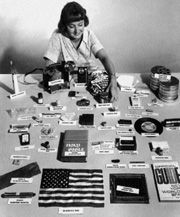FOR THE LAST half-century, time capsules have been ubiquitous—the 20th century’s answer to ribbon-cutting ceremonies, our way of commemorating new malls, golden anniversaries, and grade school graduations. Literally tens of thousands of them lie secreted or buried, filled mostly with the unimaginative stuff of everyday life: newspapers, magazines, letters, coins, and knickknacks. They offer us a way to send a message to the future, a kind of letter-in-a-bottle on the seas of time. While many are lost and forgotten, for the most part that doesn’t seem to matter: The planting of a time capsule, regardless of its contents, seems more important than whether it’s ever dug up.
The history of burying stuff for the future is ancient, and time capsule-like things can be found throughout history and in many cultures. The Sumerians buried messages to their descendants in the foundations of temples; Chinese and Tibetan Buddhists secreted away tablets inscribed with sutras specifically for discovery in the distant future; and the Freemasons have long made the laying of new building foundations a ceremonial highlight by putting objects into cornerstones. (Conspiracy buffs take note: Not only is the back of our $1 bill fraught with Masonic symbolism, but virtually every government building in Washington, DC, built before the early 1960s has a cornerstone filled and blessed by the Masons. Holy Illuminati!)
But what distinguishes these from modern time capsules? Well if you ask the experts, like Washington State University librarian William Jarvis, who has written some of the most scholarly explorations of the history of time capsules, the idea that such caches are assigned a specific opening date is a very modern idea. In other words, what defines a time capsule is not that it may be opened one day, but that it is intended to be opened on a particular date set by its creator. Thus, the pyramids, Titanic, Al Capone’s safe, and the Voyager spacecraft are not, strictly speaking, time capsules.
THE FIRST EXAMPLE of a true time capsule is, Jarvis says, the so-called Century Safe, sealed at the 1876 Centennial Exhibition in Philadelphia with the intention that it be opened in the US Capitol during the 1976 Bicentennial celebration. Remarkably, despite being lost for some years, it was.
But time capsules, as Jarvis defines them, are really much newer. The word itself was coined and popularized by G. Edward Pendray, a science fiction-writing publicist who was looking for a great stunt to kick off the Westinghouse pavilion at the 1939 New York World’s Fair, the theme of which was “The World of Tomorrow.” After rejecting the name “time bomb,” which seemed a bit off considering World War II was starting, he settled on “capsule.” Westinghouse engineers built a sleek, torpedo-shaped object out of a new copper alloy the company was trying to promote (“cupaloy”). The idea was to cram as many modern-day artifacts and as much information about our civilization as possible into a tube, bury it in the ground, and invite people 5,000 years in the future to rediscover us.
Pendray’s execution was brilliant, but his idea was not original. He actually stole it from a man who was planning an even more ambitious project: the Crypt of Civilization, a kind of Tut’s tomb of Western culture. It was conceived by Thornwell Jacobs, president of Oglethorpe University in Atlanta, Georgia. A big-picture visionary who taught a course in millennial thinking and seemed uncomfortable regarding anything in increments smaller than a century or two, Jacobs wanted to prefabricate the perfect archaeological site. Civilizations rise and fall, he reasoned, so why not build a record—an ark—to send ourselves into the future, thus preserving our culture for the benefit of earth’s future inhabitants, whoever they may be (he specifically considered that they might be aliens). He printed and distributed special metal tickets to the opening ceremony, to be held in the year 8113 AD.
These think-big projects from what has been called time capsules’ Golden Age generated extensive publicity, fed a public fascination with the future, and launched countless imitators, though many folks scaled back the time line and chose 25, 50, or 100 years for their time capsules. Americans buried everything from Chevy Vegas to asbestos to Barbie dolls, all destined for another time or our older selves. But while thousands bloomed, the ambitious time capsule—the kind meant to be catapulted into the far millennia as a definitive record of civilization today—has petered out.
You thought the Y2K bug was a bust? For years leading up to it, the International Time Capsule Society (of which I am a founder) sought to interest potential sponsors in a large-scale, millennial project. But despite the PR opportunities the year 2000 presented, none stepped forward. The main Y2K time capsule projects were more like AOL’s, which promised to archive messages to the future from members, or the suggestion from Kellogg’s that kids use their cereal boxes to create personal, though perhaps milk-sodden, capsules.
WHICH IS NOT TO SAY there haven’t been important time capsule projects since the 1930s: In 1965, Westinghouse did a second capsule, buried next to the first, filling in the historical record for the intervening 27 years, including info on nuclear power, computers, World War II, and the Beatles. And in 1970, on the occasion of Expo ’70 in Osaka, the electronics giant Matsushita (you know them as Panasonic) cosponsored the first Japanese millennial time capsule project. Instead of a tube, they chose a container that looks like a giant stewpot. Layered inside of it, like a bento box, are compartments containing a complete record of Japanese life—including at least one weird, powerful relic of the atomic bomb: the blackened fingernail of a survivor.
The Osaka ’70 capsule is unique in another respect: It is designed to be disturbed. Sort of. Instead of simply burying the capsule and crossing fingers that it won’t be unearthed until its distant opening date (6970 AD), this one has a kind of planned tampering mechanism built in—one that mirrors a Japanese tradition of tearing down and rebuilding temples at regular intervals. The Osaka capsule is buried in the ground, but buried on top of it is an exact twin. While the bottom time capsule will presumably remain inviolate for 5,000 years, the top one will be regularly disinterred and inspected every 100 years from the year 2000 on. The top capsule will not only teach conservationists about long-term preservation techniques, it increases the chance the bottom capsule will survive by maintaining its memory throughout the ages, something the Japanese are pretty good at.
Brian Durrans, Keeper of the Department of Ethnology at the British Museum, has long studied time capsules. He points out that the difference between a museum and a time capsule is that museums contain artifacts meant to be seen; time capsules contain artifacts meant to be hidden. A museum is active, Durrans says, a time capsule passive. Artifacts hidden passively can be easily lost. Ensuring that capsules are found and opened on time is problematic—if not almost impossible. But the Osaka capsule offers a slightly different model: a passive capsule that is preserved through activity.
That model could change the nature of time capsules—and has other applications. Solving the problem of preserving information or objects over many millennia is something even the US government has investigated. In 1984, a study done for the Department of Energy by Battelle Labs examined how to mark nuclear waste sites for 10,000 years. The report suggested that until the human genome can be encoded with messages for future generations, the best way to transmit information over the long term would be via an “atomic priesthood” responsible for that task. Warning signs and other means of communication simply won’t work over such time spans; human stewardship is required. Both that study and the Osaka capsule inspired a project I worked on here in Washington state. I supervised the development of a time capsule project for our 1989 Centennial Celebration that recruited hundreds of 10-year-olds as official Capsule Keepers, charged with watching over the time capsule and updating it every 25 years.
HAPPILY, THE FIRST inspection of the Osaka was only 30 years after burial and provided the occasion this September for Japan’s National Museum of Ethnology to invite an assortment of time capsule experts to come to Osaka for a symposium, “Time Capsules in the Modern World.” Organized by the museum’s Dr. Kenji Yoshida, with the assistance of Brian Durrans, it was a rare chance to assemble academics and experts with an interest in time capsules, conservation and restoration, archaeology, archives management, and the cultural aspects of memory to discuss the state of the time capsules.
Information storage technologies are rapidly changing—we’ve gone from the terra cotta disk that was de rigueur 5,000 years ago to the computer disc, which is highly ephemeral and based on technologies that are rapidly changing and quickly replaced. Computerized time capsule may be an oxymoron until we can ensure that information is instantly and completely replicated as technology turns over. In 1940, Thornwell Jacobs wasn’t entirely sure that our technological “advancement” would be ever upward, as today’s techies assume; he placed in his Crypt a hand-crank machine, much like a nickelodeon, to teach people to speak English in the eighth millennium—no electricity or computers required. Video tapes, CDs and hard drives, DVDs: Little is known about how long they’ll last or whether we’ll be able to access the information on them in 20 years, let alone several centuries.
The era of millennial time capsules seems to have been tied to a belief in big technological solutions. It’s no accident that time capsules have a long association with World’s Fairs, those Industrial Age festivals marked by Crystal Palaces, Eiffel Towers, and Space Needles. But fairs today are downsizing and changing focus: They seem less interested in suggesting bright, high-tech futures than in sustainable ways of surviving in a culturally diverse present. The concept of civilization too seems to be dwindling as a more multicultural view of the world has emerged. One symposium participant suggested that time capsules were simply a way for us to colonize the future, a kind of temporal imperialism.
It may be that enjoying time capsules for their ritualistic function is best. The only “capsule” project connected with a recent Expo I can think of was in Seville in 1992, where a group of anonymous artists built a tar pit into which people could drop objects, much like the ancients dropped votive offerings into wells.
So, time capsules, once heralded as the saviors of civilization, have evolved into a kind of postmodern neopagan performance art. At least until we rediscover the future of the past in about 5,000 years.
For more on time capsules, check out these links:
-Time capsule documentary and more time capsule links on Seanet.com.
–The Canadian Conservation Institute offers the best guide on making and opening capsules.
–New York Times Capsule project.







